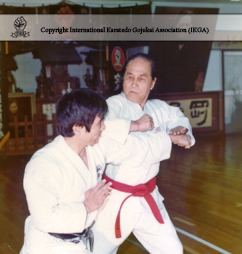

Lecture Points of Gojukai
The Goju-kai founder, Gogen Yamaguchi Sensei who learned under Chojun Miyagi Sensei unified the essential lecture points of All Japan Karate-do Federation Goju-kai. The present successor, Grandmaster Goshi Yamaguchi improved those lecture points to nurture our spirits, our Ki and our body.
Goju-kai holds seminars for high graders (over 5 Dan), seminars for instructors, seminars for black belts, other seminars and classes at each dojo. Goju-ryu also has classes for elders to study their health improvement and breathing method of Karate-do at community colleges.
The contents of practices is not only learning competitive Karate techniques, but also learning seekers' mind to enjoy Karate for our whole life. We want people to learn common sense through group activities and to know the meanings of improving themselves and challenge through participating in competitions.
Goju-kai's basic training begins with making fists, preparing and kicking. Then we start seven basic kinds of training; Tachikata, Kamaekata, Ukekata, Tsukikata, Uchikata, Atekata and Kerikata.
There are two basic Wazas; one is used for Kata and the other is used for Jiyu-kumite. Also, there are two kinds of foot movements; one is Unsoku for basic movement and the other is Tenshin and Sabaki, for Kumite.
There are four types of Katas, Kihon-kata, Fukyu-kata, Kaishu and Tokutei-kata. Sanchin and Tensho are Kihon-kata. Sometimes, Tensho is done after Kaishu-kata because it is recognized as Kaishu-kata.
In Goju-kai, Kihon-kata consists of a pair of Go Waza, or hardness and Jyu Waza, or softness. Fukyu-kata consists of 10 variations of Taikyoku no Kata and Gekisai 1 and 2. Kaishu-kata consists of Saifa, Seienchin, Seipai, Sanseiru, Shisochin, Kururunfa and Suparinpei. Tokutei-kata, which consists of Genkaku, Chikaku, Koryu and Tenryu, are prohibited from being given any instructions to students and used at competitions.
There are various kinds of practice methods as follows, Kihon-kumite, Yakusoku-kumite and Jiyu-kumite. All Kumites are pair practices and we need to give attention to basics, timing, distance and more difficult techniques in the practice.
To understand Kata, there are two methods that are Katabunkai-kumite and Bunkaikata-kumite. On Katabunkai-kumite practice, we make Katas divided and learn the meaning of each movement. Bunkaikata-kumite is a practical training method carried out through a sequence of performance of all Katas from Gekisai.
The important things are building basic strength and breathing. We need to find out our own training method to build strength suitable for Karate-do, although we can improve basic strength through daily Kata practice. The basic strength is muscular strength, endurance and flexibility to sustain hard Karate practice and it is better to add some assistance exercises to our curriculum to nurture our bones.
The breathing method is called Ibuki, and expressed In, Yo and Han In Yo doing conscious abdominal breathing. We can perform by doing Ju-ho, Go-ho, Goju-ho and Seido-ho.
Concentration on movements and breathing leads to Kiko practice.
Sanchin and Tensho are said Ritsuzen, and a standing posture with Sanchin-dachi and breathing leads to a mental state of Tenchi-jin that is the best state of Goju-ryu.

"Don't be struck by others, don't strike others and avoid trouble"
Chojun Miyagi Sensei